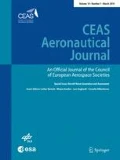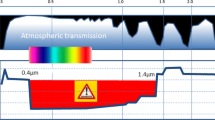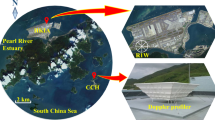Abstract
In this paper, in-flight remote sensing technologies are considered for two applications: active load alleviation of gust and turbulence and wake impact alleviation. The paper outlines the strong commonalities in terms of sensors and measurement post-processing algorithms and presents also the few differences and their consequences in terms of post-processing. The way the post-processing is being made is detailed before showing results for both applications based on a complete and coupled simulation (aircraft reaction due to disturbances and control inputs during the simulation is influencing the sensor measurements). The performances in terms of wind reconstruction quality for the gust/turbulence case and in terms of wake impact alleviation performance for the wake vortex case are shown based on simulations and are very promising.













Similar content being viewed by others
References
Ehlers, J., Fezans, N.: Airborne Doppler LiDAR sensor parameter analysis for wake vortex impact alleviation purposes. In: Bordeneuve-Guibé J, Drouin A, Roos C (eds.) Advances in aerospace guidance, navigation and control, pp 433–453. Springer, Toulouse (2015) (ISBN 978-3-319-17517-1)
Fezans, N.: An Unusual Structure for a Feedforward Gust Load Alleviation Controller, Submitted to the 2017 CEAS EuroGNC conference, 25–27 April 2017, Warsaw, Poland
Fezans, N., Joos, H.-D., Combined Feedback and LIDAR-based Feedforward Active Load Alleviation, Submitted to the 2017 AIAA Aviation/Atmospheric Flight Mechanics conference, 5 - 9 June 2017, Denver, Colorado, USA
Cézard, N., Besson, C., Dolfi-Bouteyre, A., Lombard, L.: Airflow characterization by Rayleigh-Mie Lidars. AerospaceLab 1, 1–4 (2009)
Hill, C., Harris, M.: Lidar measurement report, Technical report: Remote Sensing (UpWind WP6) – QinetiQ Lidar Measurement Report, Sept. 2010 (QINETIQ/TS/FPPS/TR0900813)
NATO: Optical Air Flow Measurement in Flight, RTO AGARDograph 160, Flight Test Instrumentation Serie –Vol. 20, Dec. 2003
Wolkensinger, C.: Vergleich messtechnischer Konzepte zur bordgestützten Ermittlung atmosphärischer Störphänomene (English title: Comparison of measurement concepts for the detection of atmospheric disturbances), DLR Technical Report IB-111/2010-35, 2010
Hirschberger, M. C.: Beiträge zur Erfassung von Wirbelschleppen mit Lidar – Simulation und Analyse rückgestreuter Signale zur Windfeldbestimmung vor Flugzeugen (English title: Contribution to the recognition of wake vortices with Lidar – Simulation and analysis of backscattered signals for the wind field determination ahead of aircraft), PhD thesis, Ludwig-Maximilian University, Munich, 2013
Sivia, D.S.: Data analysis–a bayesian tutorial, 2nd edn. Oxford University Press, Oxford (2006)
Gregory, P.: Bayesian logical data analysis for the physical sciences. Cambridge University Press, UK (2005). (ISBN-13: 978-0-521-84150-4)
Burnham, D.C., Hallock, J.N.: Chicago monostatic acoustic vortex sensing system, Wake Vortex Decay, vol. 4. National Information Service, Springfield (1982)
Lamb, H.: Hydrodynamics. Dover Publications, New York (1932). (ISBN-13 of 6th edition: 978-0486602561)
Proctor, F.H., Hamilton, D.W.: Evaluation of Fast-Time Wake Vortex Prediction Models, AIAA-2009-0344. AIAA Aerospace Sciences Meeting, Orlando (2009)
Winckelmans, G., Thirifay, F., Ploumhans, P.: Effect of non-uniform wind shear onto vortex wakes: parametric models for operational systems and comparison with CFD studies, 4th Wakenet Workshop on “Wake Vortex Encounter”, NLR, Amsterdam, The Netherlands, October 16–17th, 2000
Fabre, D., Jacquin, L.: Short-wave cooperative instabilities in representative aircraft vortices. AIP Phys. Fluids 16(5), 1366–1378 (2004)
Luckner, R.: Modeling and Simulation of Wake Vortex Encounters: State-of-the-Art and Challenges, AIAA-2012-4633, AIAA Modeling and Simulation Technologies Conference, Minneapolis, MN, USA, August 2012
Fischenberg, D.: Determination of Wake Vortex Characteristics from Flight Test Data (in German: Bestimmung der Wirbelschleppencharakteristik aus Flugmessdaten), DLRK/Deutscher Luft- und Raumfahrtkongress, Stuttgart, 23rd–26th Sept, 2002
Fischenberg, D.: A method to validate wake vortex encounter models from flight test data, ICAS 2010, 27th International Congress of the Aeronautical Sciences, Nice, France, 2010
Fraley, C.: Algorithms for nonlinear least-squares problems, Technical Report DTIC: ADA196071, May 1988
Cramér, H.: Mathematical methods of statistics. Princeton Univ. Press, Princeton (1946). (ISBN 0-691-08004-6)
Rao, C.R.: Information and the accuracy attainable in the estimation of statistical parameters. Bull Calcutta Math Soc. 37, 81–89 (1945). (MR 0015748)
Rao, C.R.: Minimum variance and the estimation of several parameters. Math. Proc. Cambridge 43(2), 280–283 (1947)
Rao, C.R.: Linear Statistical Inference and its Applications, 2nd edn. Wiley, New York (1973)
Crow, S.C.: Stability theory for a pair of trailing vortices. AIAA J. 8(12), 2172–2179 (1970)
Crow, S.C., Bate, E.R.: Lifespan of trailing vortices in a turbulent atmosphere. J. Aircr. 13(7), 476–482 (1976)
Hennemann, I.: Deformation und Zerfall von Flugzeugwirbelschleppen in turbulenter und stabil geschichteter Atmosphäre (English title: Deformation and decay of aircraft wake vortices in turbulent and stable atmosphere), PhD thesis, Technische Universität München, Germany, 2009
Loucel, R.E., Crouch, J.D.: Flight-simulation study of airplane encounters with perturbed trailing vortices. J. Aircr. 42(4), 924–931 (2005)
Bieniek, D., Luckner, R.: Simulation of aircraft encounters with perturbed vortices considering unsteady aerodynamic effects. J. Aircr. 51(3), 705–718 (2014)
Vechtel, D.: Entwicklung eines analytischen Modells zur Berechnung gekrümmter Wirbelschleppen, DLR Technical Report IB 111-2010/14, Braunschweig, March 2010
Münster, C.: Modellierung, Identifizierung und Bewertung eines analytischen Modells für gekrümmte Wirbelschleppen (English title: Modeling, Identification, and Evaluation of an Analytical Model of Curved Vortices), DLR Technical Report IB-111-2011/09, Braunschweig, March 2011
Tikhonov, A.N., Arsenin, V.Y.: Solutions of Ill-posed problems. Winston & Sons, Washington (1977)
Marr, D., Hildreth, E.: Theory of edge detection. Proc. R. Soc. Lond. Ser. B Biol. Sci. 207(1167), 187–217 (1980)
König, R., Hahn, K.-U.: Load Alleviation and Ride Smoothing Investigations Using ATTAS. In: Proceedings of the 17th congress of the international council of the aeronautical sciences, Stockholm, Sweden, 1990
Hahn, K.-U., König, R.: ATTAS Flight Test and Simulation Results of the Advanced Gust Management System LARS. Proc. of the AIAA Atmospheric Flight Mechanics Conference, Hilton Head, SC, USA, 1992
König, R., Hahn, K.-U., Winter, J.: Advanced Gust Management Systems—Lessons Learned and Perspectives. In AGARD Flight Mechanics Panel, Symposium on Active Control Technology: Applications and Lessons Learned, Torino, Italy, 1994
Schmitt, N. P., et al.: The AWIATOR Airborne LIDAR turbulence sensor, DLRK/Deutscher Luft- und Raumfahrtkongress 2005, Friedrichshafen, DGLR-2005-067, September 2005
Hecker, S., Hahn, K.-U.: Gust load alleviation system using turbulence sensor and adaptive elements. AWIATOR, Technical Report, DLR-TR-3.1.1-14, Germany, July 2006
Wildscheck, A.: An adaptive feed-forward controller for active wing bending vibration alleviation on large transport aircraft. PhD thesis, Technical University of Munich, 2009
Zeng, J., Moulin, B., de Callafon, R., Brenner, M.J.: Adaptive feedforward control for gust load alleviation. J. Guid. Control Dyn. 33(3), 862–872 (2010)
Rabadan, G.J., Schmitt, N.P., Pistner, T., Rehm, W.: Airborne lidar for automatic feedforward control of turbulent in-flight phenomena. J. Aircr. 47(2), 392–403 (2010)
European Aviation Safety Agency, Certification Specifications for Large Aeroplanes, CS 25, Amendment 3, Sept. 19th 2007, Annex to ED Decision 2007/010/R
Anderson, B.D.O., Dehghani, A.: Challenges of adaptive control–past, permanent and future. Annu. Rev. Control 32, 123–135 (2008)
Fischenberg, D.: Online wake identification algorithms using forward looking LIDAR sensor measurements, DLR Technical Report IB111-2013/11 Braunschweig, Germany, February 2013
Fischenberg, D.: Strömungsermittlungsverfahren/Flow Determination Method/Procédé de détermination d’écoulement, Patent No. EP 2 340 438 B1, European Patent Office 2013; Patent No. US 9075074 B2, United States Patent and Trademark Office 2015
Ehlers, J., Fischenberg, D., Niedermeier, D.: Wake identification based wake impact alleviation control, AIAA-2014-2591. AIAA AVIATION, Atlanta (2014)
Acknowledgements
The gust and turbulence part of this work has been funded within the framework of the European CleanSky Joint Technology Initiative—Smart Fixed Wing Aircraft (Grant Agreement Number CSJU-GAM-SFWA-2008-01) and is currently being pursued within the framework of the European CleanSky2 Joint Technology Initiative—Airframe (Grant Agreement Number CS2JU-AIR-GAM-2014-2015-01).
Author information
Authors and Affiliations
Corresponding author
Additional information
This paper is based on a presentation at the German Aerospace Congress, September 22–24, 2015, Rostock, Germany.
Rights and permissions
About this article
Cite this article
Fezans, N., Schwithal, J. & Fischenberg, D. In-flight remote sensing and identification of gusts, turbulence, and wake vortices using a Doppler LIDAR. CEAS Aeronaut J 8, 313–333 (2017). https://doi.org/10.1007/s13272-017-0240-9
Received:
Revised:
Accepted:
Published:
Issue Date:
DOI: https://doi.org/10.1007/s13272-017-0240-9




